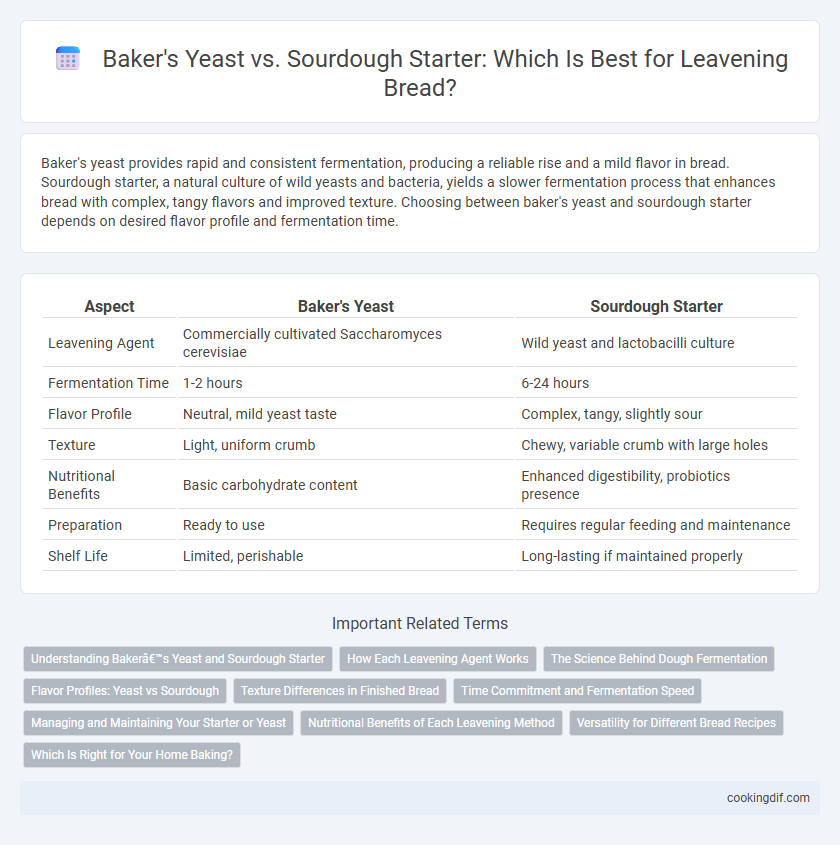Baker's yeast provides rapid and consistent fermentation, producing a reliable rise and a mild flavor in bread. Sourdough starter, a natural culture of wild yeasts and bacteria, yields a slower fermentation process that enhances bread with complex, tangy flavors and improved texture. Choosing between baker's yeast and sourdough starter depends on desired flavor profile and fermentation time.
Table of Comparison
| Aspect | Baker's Yeast | Sourdough Starter |
|---|---|---|
| Leavening Agent | Commercially cultivated Saccharomyces cerevisiae | Wild yeast and lactobacilli culture |
| Fermentation Time | 1-2 hours | 6-24 hours |
| Flavor Profile | Neutral, mild yeast taste | Complex, tangy, slightly sour |
| Texture | Light, uniform crumb | Chewy, variable crumb with large holes |
| Nutritional Benefits | Basic carbohydrate content | Enhanced digestibility, probiotics presence |
| Preparation | Ready to use | Requires regular feeding and maintenance |
| Shelf Life | Limited, perishable | Long-lasting if maintained properly |
Understanding Baker’s Yeast and Sourdough Starter
Baker's yeast, Saccharomyces cerevisiae, is a commercially cultivated leavening agent known for its rapid fermentation and consistent carbon dioxide production, essential for predictable bread rising. In contrast, sourdough starter is a natural symbiotic culture of wild yeasts and lactic acid bacteria, which ferment the dough more slowly and contribute complex flavors and improved texture through organic acid production. Understanding the microbial composition and fermentation dynamics of baker's yeast versus sourdough starter is crucial for selecting the appropriate leavening method based on desired bread characteristics and preparation time.
How Each Leavening Agent Works
Baker's yeast leavens bread by rapidly fermenting sugars, producing carbon dioxide and alcohol that cause the dough to rise quickly. Sourdough starter relies on a symbiotic culture of wild yeast and lactic acid bacteria, which ferment sugars more slowly, generating carbon dioxide and organic acids that develop complex flavors and a tangy texture. The slower fermentation process in sourdough enhances gluten development and results in a chewier crumb compared to the fast-acting leavening power of baker's yeast.
The Science Behind Dough Fermentation
Baker's yeast (Saccharomyces cerevisiae) rapidly ferments sugars, producing carbon dioxide and ethanol that cause dough to rise quickly, resulting in a soft, airy crumb with a mild flavor profile. Sourdough starter harnesses wild yeast and lactic acid bacteria, generating organic acids and complex flavor compounds through a slower fermentation process that enhances dough acidity, texture, and shelf life. The balance of microbial activity in sourdough fermentation impacts gluten structure development and gas retention, creating a denser crumb and tangier taste compared to the straightforward enzymatic action of baker's yeast.
Flavor Profiles: Yeast vs Sourdough
Baker's yeast produces a bread with a mild, slightly sweet flavor and a soft, uniform crumb due to its fast fermentation process. In contrast, sourdough starter fermentation develops complex, tangy, and slightly acidic notes from wild yeast and lactic acid bacteria, creating a distinctive depth of flavor and chewier texture. The lactic and acetic acids in sourdough contribute to its characteristic sourness and enhanced aroma, setting it apart from the cleaner taste of yeast-leavened bread.
Texture Differences in Finished Bread
Baker's yeast produces a consistent, airy crumb with uniform holes, resulting in a soft and tender texture ideal for sandwich breads and rolls. Sourdough starter creates a denser crumb with irregular holes, adding a chewy, complex mouthfeel and a slightly tangy flavor that enhances artisanal loaves. The organic acids in sourdough also improve crust crispness, providing a distinctive contrast to the mild, softer crust formed by baker's yeast.
Time Commitment and Fermentation Speed
Baker's yeast offers rapid fermentation, typically leavening bread within 1 to 2 hours, making it ideal for quick baking with minimal time commitment. In contrast, sourdough starter requires a longer fermentation process, often ranging from 8 to 24 hours, due to the natural wild yeast and lactic acid bacteria involved. This slow fermentation enhances flavor complexity but demands advanced planning and consistent starter maintenance.
Managing and Maintaining Your Starter or Yeast
Managing baker's yeast involves storing it in a cool, dry environment, typically refrigerated, to preserve its viability and ensure consistent fermentation. Sourdough starter requires regular feeding with flour and water, maintaining a warm environment between 70-75degF (21-24degC) to promote active microbial growth and optimal leavening power. Both methods need careful monitoring of hydration levels and frequency of use to sustain yeast activity and achieve desired dough rise.
Nutritional Benefits of Each Leavening Method
Baker's yeast accelerates fermentation, producing bread with a slightly higher glycemic index but enriched with B vitamins like folate and niacin. Sourdough starter uses wild yeast and lactobacilli, enhancing bioavailability of minerals such as magnesium and zinc through natural phytate breakdown. These nutritional differences influence digestion and nutrient absorption, with sourdough often favored for its probiotic potential and lower glycemic impact.
Versatility for Different Bread Recipes
Baker's yeast offers consistent and rapid fermentation, making it ideal for a wide range of bread recipes, from sandwich loaves to pizza dough. Sourdough starter provides unique flavor profiles and extended fermentation times, enhancing artisan breads like ciabatta and rye with natural acidity and complex aromas. Both leavening agents bring distinct versatility, allowing bakers to tailor texture, taste, and crust characteristics according to specific recipe requirements.
Which Is Right for Your Home Baking?
Baker's yeast offers consistent and rapid fermentation, ideal for quick bread recipes and reliable results in home baking. Sourdough starter provides natural wild yeast and beneficial bacteria, creating complex flavors and longer shelf life but requires more time and maintenance. Choosing between them depends on your preference for speed and simplicity versus flavor depth and artisanal process.
Baker's yeast vs Sourdough starter for leavening Infographic

 cookingdif.com
cookingdif.com